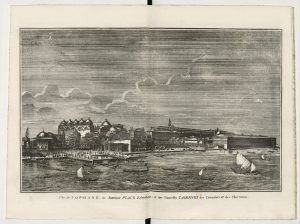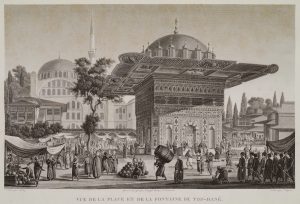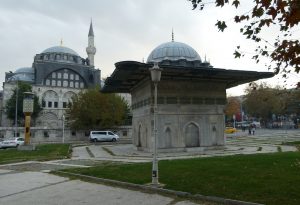Montag, November 14th, 2016...11:47
„Top-hanä“ (Tophane) – A Cross-Media Comparison
When looking at the location of Tophane, we have the possibility to compare different sources with different media of representation. First there are of course the written descriptions by Ulrich Japer Seetzen from 1802-1803. At the very beginning of his time in Istanbul Seetzen shortly describes the location which he calls „Top-hanä“.
15. Dezember 1802:
„Wir kamen nach Top-hanä, ein Ort mit einem großen Gebäude am Ufer des Canals erbaut; auf dem dazugehörigen Hofe lagen viele steinerne Kanonenkugeln, welche zum Theil sehr groß waren. Daneben war ein öffentlicher Platz, auf welchem ein prächtiger Brunnen steht. Das 4eckige Gebäude, welches ein sehr vorspringendes Dach hat, ist fast überall vergoldet und mit goldenen türkischen Inschriften bedeckt. Auf diesem Platz ist vorzüglich viel Gewühl […].“ (Seetzen 2012: p. 24)
Later in his traveldiary he also refers to a visual source by the ottoman painter Mahmud Raif Efendi, who illustrates the place of Tophane as an engraving from the seaside. He is complaining on the inaccuracy of the graphic, caused by the use of certain acid and gives advices for a better perspective of the scenery. Despite the mentioned critique by Seetzen this passage is valuable to understand and reconstruct his use of literature and sources.
19. März 1803
„Man findet in des ietzigen Reïs Efendi’s, Mohammed Rayf, bekanntem Werke, Tableau des nouveaux reglens de L’Empire ottomane, a Constantinople 1798, Folio, eine getreu gezeichnete Ansicht von diesem Gebäude nebst dem Marktplatz und der auf demselben befindlichen prachtvollen Springbrinnen; iedoch ist es zu bedauern, daß der Künstler, der sich des Scheidewassers [Salpetersäure] bediente, die Kupferplatte schlecht ätzte, wodurch diese Zeichnung sehr undeutlich geworden ist. Eine ausgedehntere Ansicht von Top-hanä, wo man im Vordergrund den Canal mit seinen zahlreichen Gondeln, nebst dem Marktplatze, der ansehnlichen Moschee, dem Springbrunnen und den Caffeeeboutiken und dem Menschengewühle hätte, im Mittelpunkt die angeführten Gebäude, und im Hintergrund die an dem Berg sich hinaufziehende Häusermenge mit dazwischenstehenden Bäumen, würde ungemein interessant und lehrreich seyn.“ (Seetzen 2012: p. 217-218)

Image 1. „Vue de Tophané, ou Ancienne Place d’Artillerie, et des Nouvelles Casernes des Canoniers et des Charetiers“, Mahmud Raif Efendi, 1798.
Another visual source from almost the same period is from the german painter Antoine Ignace Melling, who lived for 18 years in Istanbul (from 1784-1802) and worked many years as imperial architect of Sultan Selim III.. He becomes famous for his 1819 published detailled engravings of his „Voyage pittoresque de Constantinople et des Rives de Bosphore“. In two volumes he visually describes mainly the architecture of the ottoman Capital and its surroundings places with a special regard to the social life of the cities inhabitants. Even we don’t exactly know if Seetzen and Melling met each other in Istanbul, the 1819 in Paris published Prints are representing probably more or less the same city as Seetzen saw.
In his depiction of Tophane square with the Fountain in the center and Kiliҫ Ali Paşa Mosque in the background, Melling portrayed a vivid and busy market szene. In focusing on the social dimension of the place, he is showing male and female customers, divers professions like melon-sellers, chimmney sweepers, carriers and members of different military units (see also Debold-Kritter: 2012).
In comparison the following photography shows todays Tophane-square from same perspectie as Mellings engraving from 1819. As you can see in the picture the architecture of the two main buildings have not changed so much, but the social, cultural and economic meaning of the square totally differs. In contrast to the illustration of Melling, it seems that the place lost it’s importance as a meetingpoint for peoples everyday life in exchanging goods and information. The impressive fountain with it’s beautiful marble calligraphys and decorations is becoming more and more a relict of ottoman period.
Beside describing different buildings and the economic infrastructure surrounding the Tophane-Fountain, Seetzen is also writing about the relation between humans and animal in marine environment. Somehow he is wondering abotu the fearlessness of the gulls, which are flying around the gondola. When going by ferry, you can still see a lot of gulls flying in swarms around the ships, trying to get some of the pieces of Simit – popular sesame-rings – thrown by people in the air.
„Möwen schwebten in langsamem kurzem Fluge theils einzeln, theils in zahlreichen Haufen um unsere Gondel und die übrigen Fahrzeuge herum, oder schaukelten sich in den Wellen. Sie scheinen die Menschen hier nicht zu fürchten, weil es verboten ist, sie zu schießen. […]“. (Seetzen 2012: p. 35)
Text by Yasar Wentz
Sources:
Debold-Kritter, Astrid (2012): Mellings Darstellung des multi-ethnischen Lebens in Konstantinopel um 1800. Voyage pittoresque de Constantinopel et des Rives du Bosphore. EOTHEN Sonderdruck, Münchner Beiträge zur Geschichte der Islamsichen Kunst und Kultur. Band V, München: Scaneg Verlag.
Seetzen, Ulrich Jasper (2012): Tagebuch des Aufenthalts in Konstantinopel und der Reise nach Aleppo 1802 – 1803.
bearb. von Volkmar Enderlein, Documenta Arabica, Teil 1: Reiseliteratur, Hildesheim, Zürich, New York: Georg
Olms.
Images:
Image 1. http://gallica.bnf.fr/ark:/12148/bpt6k853880w, 17.11.2016
Image 2. http://eng.travelogues.gr/item.php?view=50262, 17.11.2016
Image 3. Own work by Detlev Quintern, 09.11.2016
Video: Own work by Yasar Wentz, 19.11.2016


Schreibe einen Kommentar